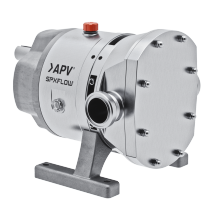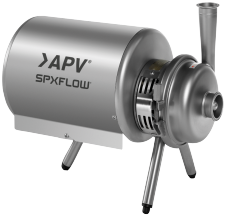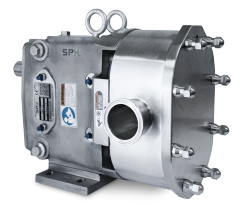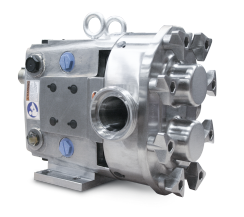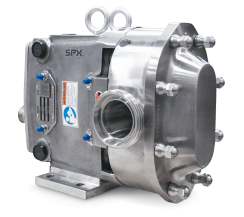What Makes a Pump Aseptic?
Aseptic pumps are advanced mechanical devices that are designed for use in the pharmaceutical, biotechnology, and food and beverage industries, among others. These pumps are specifically engineered to prevent contamination of the product being pumped by minimizing the presence of microorganisms and other contaminants.
The operation of aseptic pumps is based on several advanced principles of fluid dynamics and materials science. At their core, aseptic pumps rely on a combination of positive displacement and hermetic sealing to prevent contamination.
Positive displacement is a principle in fluid dynamics that ensures a fixed volume of fluid is delivered with each pump cycle. This means that aseptic pumps can deliver precise amounts of fluid with each cycle, which is critical for many pharmaceutical and biotech applications.
Hermetic sealing refers to a completely airtight and leak-proof seal between the pump and the fluid being pumped. This seal is achieved through the use of specialized materials and manufacturing techniques that eliminate any gaps or crevices where microorganisms or other contaminants could accumulate.
In addition to these core principles, aseptic pumps also incorporate a number of advanced features and technologies to further enhance their performance and reliability. For example, some pumps may use special coatings or surface treatments to further minimize the risk of contamination, while others may use advanced sensors and control systems to monitor and regulate pump performance in real-time.
Pumps that can be configured as aseptic pumps
There are several types of pumps that can be configured as aseptic pumps. These pumps are designed to meet the stringent requirements of the pharmaceutical, biotechnology, and food industries where contamination must be avoided at all costs. The following are some of the pumps that can be configured as aseptic pumps:
 AODD pumps: These pumps use a flexible diaphragm to transfer fluids. They are often used in applications where sterility is critical because they can be designed to eliminate dead spaces and crevices where bacteria and other microorganisms can grow.
AODD pumps: These pumps use a flexible diaphragm to transfer fluids. They are often used in applications where sterility is critical because they can be designed to eliminate dead spaces and crevices where bacteria and other microorganisms can grow.  Centrifugal pumps: These pumps are widely used in the food and beverage industry for transferring liquids. They can be configured as aseptic pumps by using special seals, gaskets, and other components that eliminate the possibility of contamination.
Centrifugal pumps: These pumps are widely used in the food and beverage industry for transferring liquids. They can be configured as aseptic pumps by using special seals, gaskets, and other components that eliminate the possibility of contamination.  Lobe pumps: These pumps use two rotating lobes to transfer fluid. They are often used in the food and beverage industry because they can handle viscous fluids and solids without damaging them. They can be configured as aseptic pumps by using special seals and gaskets that eliminate the possibility of contamination.
Lobe pumps: These pumps use two rotating lobes to transfer fluid. They are often used in the food and beverage industry because they can handle viscous fluids and solids without damaging them. They can be configured as aseptic pumps by using special seals and gaskets that eliminate the possibility of contamination.  Magnetic drive pumps: These pumps use a magnetic field to transfer fluid. They are often used in applications where the fluid being transferred is hazardous or corrosive. They can be configured as aseptic pumps by using special materials and designs that eliminate the possibility of contamination.
Magnetic drive pumps: These pumps use a magnetic field to transfer fluid. They are often used in applications where the fluid being transferred is hazardous or corrosive. They can be configured as aseptic pumps by using special materials and designs that eliminate the possibility of contamination.
Advantages of aseptic pumps
There are several advantages of aseptic pumps in industrial processes. Some of the key advantages are:
- Reduced contamination risk: Aseptic pumps are designed to prevent contamination of the process stream. They use hermetic seals and have no crevices or dead spaces where bacteria or other microorganisms can grow. This reduces the risk of contamination and helps maintain the sterility of the process.
- Improved product quality: Aseptic pumps help maintain the integrity of the product by preventing contamination and minimizing exposure to air. This can improve the quality and shelf life of the product, which is especially important for food, beverage, and pharmaceutical products.
- Flexible design: Aseptic pumps can be designed to meet specific process requirements, with a wide range of sizes, flow rates, and pressure capabilities. This makes them suitable for a variety of applications and industries, including food and beverage, pharmaceuticals, and biotechnology.
Industries and applications that USE aseptic pumps
 Aseptic pumps are used in a variety of industries where maintaining the sterility of the product is critical. One such industry is the pharmaceutical industry, where aseptic pumps are used to transfer sterile products during the production process. Aseptic pumps are considered to be a critical component of the sterile manufacturing process and are required by regulatory agencies such as the FDA.
Aseptic pumps are used in a variety of industries where maintaining the sterility of the product is critical. One such industry is the pharmaceutical industry, where aseptic pumps are used to transfer sterile products during the production process. Aseptic pumps are considered to be a critical component of the sterile manufacturing process and are required by regulatory agencies such as the FDA.
 Another industry that makes use of aseptic pumps is the food and beverage industry. In this industry, aseptic pumps are used to transfer liquids and semi-solids such as fruit juices, dairy products, and sauces, while maintaining the sterility of the product. Aseptic pumps are also used in the biotech industry for cell culture applications, where sterility is critical to maintaining the health of the cells.
Another industry that makes use of aseptic pumps is the food and beverage industry. In this industry, aseptic pumps are used to transfer liquids and semi-solids such as fruit juices, dairy products, and sauces, while maintaining the sterility of the product. Aseptic pumps are also used in the biotech industry for cell culture applications, where sterility is critical to maintaining the health of the cells.
The advantages of aseptic pumps are numerous. First and foremost, aseptic pumps prevent contamination and maintain the sterility of the product. This is crucial for pharmaceutical and food industries, where even the slightest contamination can render a product unusable. Aseptic pumps are also highly efficient, providing consistent flow rates and preventing blockages, which can be a major problem in other types of pumps.
Important considerations when selecting aseptic pumps
When selecting aseptic pumps, several important considerations should be taken into account:
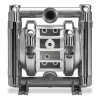 Material compatibility: The material of the pump and its components should be selected carefully to ensure compatibility with the process fluids and cleaning agents used in the application. This is particularly important in applications that involve corrosive or abrasive fluids.
Material compatibility: The material of the pump and its components should be selected carefully to ensure compatibility with the process fluids and cleaning agents used in the application. This is particularly important in applications that involve corrosive or abrasive fluids. - Sterilization method: Aseptic pumps can be sterilized using a variety of methods, including steam, hydrogen peroxide, and irradiation. The sterilization method should be selected based on the requirements of the application.
- Cleanability: The pump and its components should be designed to be easily cleaned to prevent contamination. The pump should be easy to disassemble and reassemble, with smooth surfaces and no crevices that can trap fluids.
- Validation and documentation: Aseptic pumps are often used in regulated industries, such as pharmaceuticals and biotech, where validation and documentation are required. The pump manufacturer should provide documentation that demonstrates the pump's compliance with regulatory requirements.
Why buy aseptic pumps from AxFlow?
AxFlow provides aseptic pumps that cater to an extensive variety of industries and applications. Exclusive to AxFlow, you will be provided with personalized recommendations from highly experienced process engineers and access to the most prominent process technology manufacturers that are independent of the manufacturer. If you require assistance in selecting the appropriate pumps that satisfy your requirements, feel free to contact AxFlow without any delay. AxFlow's engineers and specialists can help with the selection process, specifications, installation, and maintenance of your fluid handling equipment.


